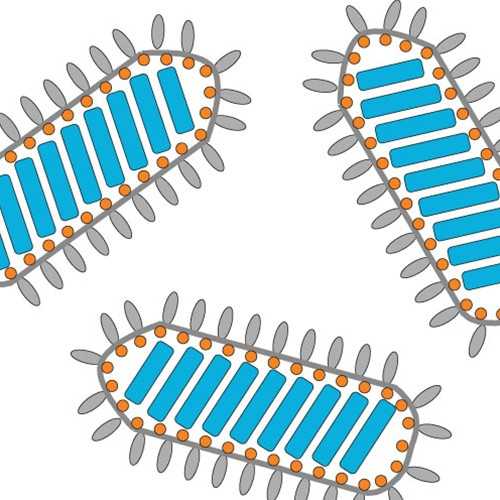Pseudotyped ΔG-DsRed (G*ΔG-DsRed) rVSV
ΔG-DsRed is a replication-restricted, recombinant vesicular stomatitis virus (rVSV) that can be used to produce pseudotype viruses containing the envelope glycoproteins from a wide variety of heterologous viruses, including those that require BSL-3 or BSL-4 biocontainment; however, because the infectivity of rVSV-ΔG pseudotypes is restricted to a single round of replication, the pseudotypes can be handled using BSL-2 containment practices. These properties, together with the rapid replication kinetics of rVSV-ΔG pseudotypes, have proven useful in studies designed to identify cellular receptors for numerous viruses, and they also provide a robust platform to screen libraries for entry inhibitors and to evaluate the neutralizing antibody responses following vaccination [1].
When ordering this reagent, a vial of VSV-G pseudotyped ΔG-DsRed (G*ΔG-DsRed) will be sent which can directly be used to generate pseudotypes containing your envelope protein of choice by following the procedures described in [1]. Infection of cells with G*ΔG-DsRed results in detectable DsRed fluorescence within 4-6 hours of infection, and very bright DsRed fluorescence by 12-18 hours post-infection. Infectivity can be quantified by fluorescence microscopy or flow cytometry. Because G*ΔG-DsRed undergoes a single-round of infection, each DsRed positive cell represents one infectious unit of virus. It is recommended that the user also order the plasmid pCAGGS-G, which is used to generate additional working stocks of G*ΔG-DsRed.
It is the responsibility of the principal investigator to seek Institutional Biosafety Safety Committee approval for recombinant DNA, transgenic animal or infectious agent use within their laboratory spaces and maintain an Institutional Biosafety Safety Committee approval during the time period these materials are used.
From the laboratory of Michael A. Whitt, Ph.D., University of Tennessee.
 Part of The Investigator's Annexe program.
Part of The Investigator's Annexe program.
ΔG-DsRed is a replication-restricted, recombinant vesicular stomatitis virus (rVSV) that can be used to produce pseudotype viruses containing the envelope glycoproteins from a wide variety of heterologous viruses, including those that require BSL-3 or BSL-4 biocontainment; however, because the infectivity of rVSV-ΔG pseudotypes is restricted to a single round of replication, the pseudotypes can be handled using BSL-2 containment practices. These properties, together with the rapid replication kinetics of rVSV-ΔG pseudotypes, have proven useful in studies designed to identify cellular receptors for numerous viruses, and they also provide a robust platform to screen libraries for entry inhibitors and to evaluate the neutralizing antibody responses following vaccination [1].
When ordering this reagent, a vial of VSV-G pseudotyped ΔG-DsRed (G*ΔG-DsRed) will be sent which can directly be used to generate pseudotypes containing your envelope protein of choice by following the procedures described in [1]. Infection of cells with G*ΔG-DsRed results in detectable DsRed fluorescence within 4-6 hours of infection, and very bright DsRed fluorescence by 12-18 hours post-infection. Infectivity can be quantified by fluorescence microscopy or flow cytometry. Because G*ΔG-DsRed undergoes a single-round of infection, each DsRed positive cell represents one infectious unit of virus. It is recommended that the user also order the plasmid pCAGGS-G, which is used to generate additional working stocks of G*ΔG-DsRed.
It is the responsibility of the principal investigator to seek Institutional Biosafety Safety Committee approval for recombinant DNA, transgenic animal or infectious agent use within their laboratory spaces and maintain an Institutional Biosafety Safety Committee approval during the time period these materials are used.
From the laboratory of Michael A. Whitt, Ph.D., University of Tennessee.
 Part of The Investigator's Annexe program.
Part of The Investigator's Annexe program.
| Catalog Number | Product | DataSheet | Size | AVAILABILITY | Price | Qty |
|---|
REQUIREMENTS
US customers - The USDA APHIS VS 16-6 or 16-6A permit must be obtained and a copy of the permit must be sent to Kerafast here, in advance of shipment. The Application Form VS 16-3 (Import controlled material import or transport organisms or vectors) must be submitted to USDA APHIS Veterinary Services to obtain the VS 16-6 or 16-6A permit.
Non-US customers - A BIS permit will be required in order to ship this product. Purchase restricted to End Users only. Please Contact Us for more information
| Product Type: | Virus |
| Biosafety Level: | BSL-2 |
| Vector Information: | G*ΔG-DsRed was recovered using the VSV reverse genetics system as described in [1] from the plasmids pVSV-ΔG-DsRed, pBS-N-ΦT, pBS-P-ΦT, pBS-G-ΦT and pBS-L-ΦT. Following recovery, a plaque isolate (plaques can be obtained on cells transiently expressing VSV-G) was amplified on BHK-21 cells transfected with pCAGGS-G. Secondary working stocks were generated by infecting BHK-21 cells transfected with pCAGGS-G at low multiplicity (MOI = 0.1) and titered on BHK-21 cells. |
| Virus: | VSV-G pseudotyped ΔG-DsRed (G*ΔG-DsRed) |
| Titer: | ≥ 6x10e8 IU/mL |
| Serotype: | Indiana/San Juan |
| Inoculation Conditions: | To generate pseudotypes with heterologous envelope glycoproteins, cells (BHK-21 or HEK-293) are first transfected with a plasmid expressing the glycoprotein of choice and ~24 hrs later infected with G*ΔG-DsRed at a multiplicity (MOI) of ~3 to 5. To generate working stocks of G*ΔG-DsRed, cells that have been transfected with pCAGGS-G are infected with G*ΔG-DsRed at low multiplicity (MOI = 0.1) and culture supernatants harvested ~18-24 hrs post-infection. |
| Comments: | For suggested protocol, see: Whitt, MA, J. Virol. Methods, 2010. 169(2): p. 365-74. |
| Storage: | Store at -80C. Multiple freeze/thaw cycles not recommended. |
| Shipped: | Frozen on Dry ice |
- Whitt, M.A., Generation of VSV pseudotypes using recombinant DeltaG-VSV for studies on virus entry, identification of entry inhibitors, and immune responses to vaccines. J. Virol. Methods, 2010. 169(2): p. 365-74.
If you publish research with this product, please let us know so we can cite your paper.


